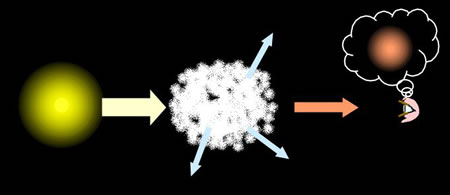Interstellar Reddening

Dust grains in the interstellar medium have a typical size that is comparable to the wavelength of blue light. The result is that the blue light coming from distant objects is strongly absorbed and scattered by the dust, essentially removing it from the light reaching us and making the objects appear redder than they really are. This is known as interstellar reddening and must be taken into account by astronomers analysing data taken at optical wavelengths in particular.
The reddening of an object is inversely proportional to the wavelength of optical light, so shorter wavelengths (blue) are more heavily reddened than longer (red) wavelengths. We can determine the degree of reddening by measuring the colour index (B-V) of the object and comparing that to its true colour index (B-V)0 through the equation:
E(B-V) = (B-V) – (B-V)0
Since both interstellar reddening and extinction are the result of the interaction of starlight with dust grains, they are inextricably linked and we should expect that the more dust along the line of sight, the more pronounced the reddening and the higher the extinction. This is indeed what is found, with extinction and reddening linked by the equation:
AV = 3.2E(B-V)
where AV is the extinction measured in the V band.
To calculate the correct distance (in parsecs) to an object taking into account extinction, we must expand the distance equation to be:
d = 10 0.2(m-M+5-AV)
By subtracting the extinction in the exponent of this equation, we are brightening the magnitude to account for loss of light.
Study Astronomy Online at Swinburne University
All material is © Swinburne University of Technology except where indicated.

